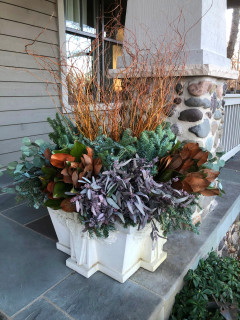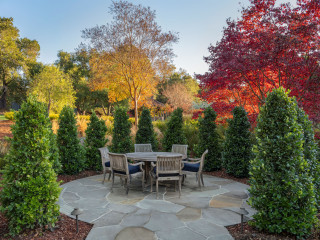
This article was originally published by a www.houzz.com . Read the Original article here. .

Magnolia leaves, evergreen branches and bell cups (available at florists and craft stores) create a stylish base for this container in New York by The Inspired Garden. Pops of silver from the painted lotus pods, berry baubles and carefully placed decorative bird in the background give the design a personalized look that will still be timely and celebratory in the new year.
Designer Laura Janney, who created this container, says she’ll often use white to stand out against a dark house or backdrop, with gold and silver accents adding a festive sparkle. “People should have fun with it. Little birds are so cute. I think [the design] can really reflect your personality,” she says.
This article was originally published by a www.houzz.com . Read the Original article here. .

In cold-winter regions, shut off any exterior water systems before cold weather hits. Then open the tap and drain the lines to prevent damage. Finally, disconnect any hoses. Do the same for any water lines leading to an outdoor kitchen.
At the same time, drain and clean any outdoor water features, such as fountains and ponds.
In warmer regions, check that your irrigation system is still working correctly. Repair or replace any sprinkler heads or drip system components as needed. Cut back on watering frequency as the weather cools. If rainfall is sufficient, turn the system off.
Even if you live in a warmer area, it’s a good idea to keep an eye on winter forecasts. Insulate exterior pipes and taps if a freeze is predicted, especially one that will last several days. Another option is to open the taps slightly to allow water to slowly drip out.
This article was originally published by a www.houzz.com . Read the Original article here. .
If you plan to be away during the season (and your area gets snow), hire a service in advance to clear the snow while you are away. Some cities give tickets if you allow the sidewalk in front of your home to become impassable, because this creates unsafe conditions for pedestrians.